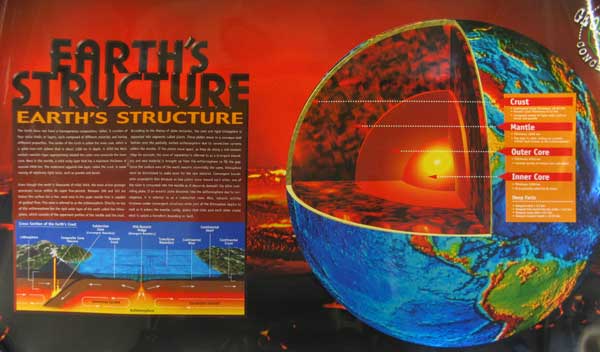
Approximate dimensions: H:50” W:33"
Cambridge Research Group poster 1999
The Earth does not have a homogeneous composition; rather, it consists of four main shells or layers, each composed of different materials and having different properties. The center of the Earth is called the inner core, which is a solid iron-rich sphere that is about 1300 km in depth. A 2250 km thick molten metallic layer appropriately labeled the outer core surrounds the inner core. Next is the mantle, a solid rocky layer that has a maximum thickness of around 2900 km. The outermost eggshell-like layer, called the crust, is made mainly of relatively light rocks, such as granite and basalt.
Even though the earth is thousands of miles thick, the most active geologic processes occur within its upper five-percent. Between 100 and 325 km below the surface lies a hot, weak area in the upper mantle that is capable of gradual flow. This zone is referrred to as the asthenosphere lies the rigid outer layer of the earth called the lithosphere, which consists of the uppermost portion of the mantle and the crust.
According to the theory of plate tectonics, the cool and rigid lithosphere is separated into segments called plates. These plates move in a conveyor-belt fashion over the partially melted asthenosphere due to convection currents within the mantle. If the plates move apart, as they do along a mid-oceanic ridge for example, the zone of separation is referred to as a divergent boundary and new material is brought up from the asthenosphere to fill the gap. Since the surface area of the earth remains essentially the same, lithopshere must be diminished to make room for the new material. Convergent boundaries accomplish this because as two plates move toward each other, one of the slabs is consumed into the mantle as it descends beneath the other overriding plate. If an oceanic plate descends into the asthenosphere due to convergence, it is referred to as a subduction zone. Also, volcanic activity increases under convergent situations when part of the lithosphere begins to melt as it enters the mantle. Lastly, plates that slide past each other create what is called a transform boundary or fault.
CRUST
- Continental Crust Thickness: 19-64 km
- Oceanic Crust Thickness: 6-11 km
- Composed mainly of light rocks such as basalt and granite
MANTLE
- Thickness: 2900 km
- Top layer is solid, resting on a partly molten layer known as the asthenosphere
OUTER CORE
- Thickness: 2250 km
- Consists mainly of molten iron and nickel
INNER CORE
- Thickness: 1300 km
- It is primarily solid iron and nickel
Deep Facts
- Deepest mine = 3.7 km
- Deepest hole bored into the earth = 14.5 km
- Deepest ocean dive = 9.7 km
- Deepest oceanic trench = 11.25 km